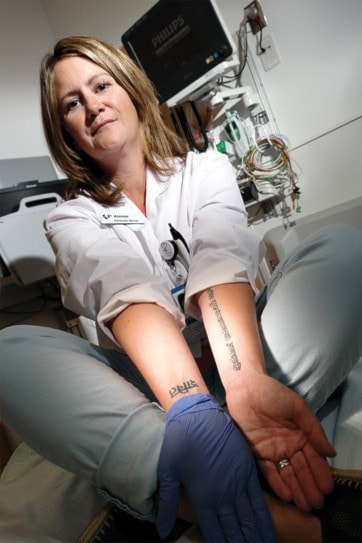Intricate black Sanskrit runs down Aimee Falkenberg’s left forearm, a tattoo tribute for 210 sexually assaulted, abused or trafficked men, women and children and all those who will come after.
A forensic nurse in Nanaimo and Surrey, Falkenberg has examined dozens of people experiencing the worst days of their lives, such as 15-year-old girls who wake at a party, pants gone, with no memory of the last five hours. Sex trade workers who weren’t listened to when they said no and men who were assaulted but faced the stigma of no one believing them.
With a read of her medical legal report, she can remember every single one.
Maybe not the colour of their hair or earrings or even the clothing they were wearing, but she remembers their souls. Their stories are heart wrenching and yet those people would stand in front of her, give her a hug and walk out.
“Sometimes I’d drive home crying and try to figure out, like where does this strength come from?” she said, looking down at the inked answer on her arm: strength comes from an indomitable will.
“They just have the strength within them that they have no idea they had.”
It’s just minutes after noon on Monday. Falkenberg has finished her shift at Nanaimo Regional General Hospital’s emergency department and takes a seat on a shaded concrete step nearby, her crisp white lab coat resting on a purse beside her. Nanaimo is where some patients will arrive to have a forensic nurse assure them their body is OK. That they aren’t pregnant, or have a sexually transmitted infection and where they’ll have the choice between having forensic evidence collected and stored at the hospital so they can file police report later, or give one immediately. They are of all ages and genders and have stories of violence that span elder abuse to sexual assault and intimate partner violence. Falkenberg, one of nine forensic nurses in Nanaimo, is trained to be their documenter and a link between medical care and the judicial system, taking meticulous notes, measurements, swabs and catalogue of bruises, abrasions and lesions. It’s a long process, taking up to six hours, but she’s honoured to sit there and listen to her patients’ stories, she said – and always she tells them how proud she is they are doing the examination.
Falkenberg got her start as a forensic nurse at Surrey Memorial Hospital in 2008, but began working as a casual in Nanaimo two years ago when her family moved to the Island. The program in this city is more than a decade old and sees just over 100 patients annually. NRGH alone saw 60 in the last fiscal year, an increase from the year previous, according to Carrie Homuth, regional manager of trauma services.
Island Health is considering using a new toolkit, the first of its kind in Canada and co-created by Falkenberg, to help health providers recognize trafficked patients. She developed it with two colleagues during her time at Surrey Memorial, recognizing many patients were showing red flags of human trafficking. She sees those same flags in Nanaimo, mostly with teens 14 to 19 years old.
They may not directly come out and say they are trafficked, she said, but could say they are having sex with up to 25 men a day or being moved from Victoria to Nanaimo, Nanaimo to Vancouver.
Often health care is the trafficked person’s first point of contact to ask for help, said Falkenberg, who sees the kit as a way to prepare others to notice those red flags and create awareness of those who might be too scared to tell their story.
When Falkenberg walks into the room, patients could be crying or not making eye contact.
It’s what they come burdened with.
A 15-year-old girl who has had a drug-facilitated sexual assault could arrive at the emergency department with her mom and dad, make-up streaked across her faced after coming home from a party. She’d been drinking with friends at 11 p.m., and woke up at 5 a.m., pants off, with no memory of those hours in between. There’s guilt and shame for drinking under age. She’s vomiting from the effects of the alcohol and what could have potentially gone into her drink. She is overwhelmed, worried her mom and dad are angry and embarrassed her brothers or sisters will find out.
“So when I say how proud I am of them when I do these examinations of them, look at what they come with.”
Examination done, Falkenberg always walks her patients out the door. She won’t hold their hands, but she’ll walk beside them.
It’s a feeling of support and when she goes back to her office, finishes up her documentation, folds up her papers and puts them in an envelope, there’s a belief that she saw a certain look on her patient’s face: hope and a little bit of strength.
